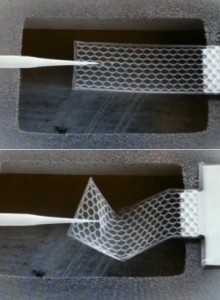The Thinnest Material that You Can Handle

Researchers from Penn University have developed the thinnest film that can be manipulated. The aluminum oxide corrugated plates, thousands of times thinner than a paper sheet, can be bent and squeezed and return to its original shape. The findings were published in the journal Nature Communications.
Engineers have constantly been trying to design new materials that are light, resistant and thin. These qualities are very valuable in aviation and for other structural applications. Currently, many thin materials don´t recover their original shape when deformed. Researchers have been able to obtain promising atomic level designs, but these materials worked poorly out of the lab environment. Graphene, for example, allows to obtain one-atom thick films, but they need a backing structure; otherwise they clump or curl up. In some experiments, graphene sheets have been supported with a frame, but the weight of the frame eliminates one of the main properties of ultra-thin films: lightness. On the other hand, nanoscale materials are hard to handle on the macroscopic scale.
Corrugated materials on the nanoscale
Professor Igor Bargatim and his team developed a new technique to strengthen nanomaterials without adding too much weight. They developed a corrugated, honey-combed film, which is no longer one-dimensional but keeps a flat structure. The plates are made of aluminum oxide, between 25 and 100 nanometers thick. Despite actually being a ceramic, aluminum oxide in these structures behaves more like a plastic regarding to its deformability. Their stiffness allows to pick them up from one side without bending on the other end. Damage is also more limited than in common plates: cracks stop at the corrugation walls instead of expanding to the whole structure.
The corrugated nanoplates are a case of mechanical metamaterials, those that achieve certain properties by the special arrangement of their nanoscale characteristics. The authors think that the new material could be used to design the wings of flying robots inspired in insects, or in other cases where the combination of strength and lightness is important.
Source: Penn News

